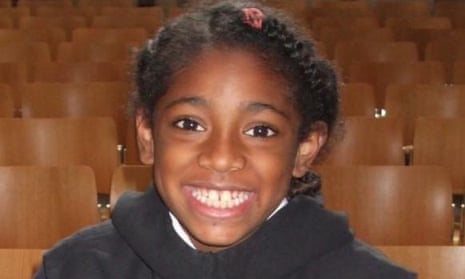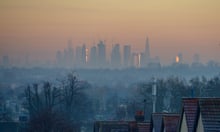The evening before she died, Ella Kissi-Debrah picked the outfit she wanted to wear to her primary school disco the following day: new jeans and a checked top. Her mother laid them out next to her school uniform, but a few hours later the nine-year-old suffered an acute asthma attack. She never made it to the party.
“We ended up burying her in the clothes instead,” said her mother, Rosamund. “I didn’t know whether it was the right thing to do, but it felt right at the time.”
The statistic that at least 40,000 premature deaths a year are caused by toxic levels of air pollution in the UK is often repeated, yet it can be hard to visualise the devastating human impact of the failure to take decisive action to clean our air.
New evidence released this week, however, has changed that. In an expert report for Ella’s family, her serious form of asthma and her death in February 2013 are linked directly to the illegal levels of pollution from diesel traffic thundering daily down London’s South Circular Road near her home.
Her family are now fighting for a new inquest to cite air pollution as a cause of her death in what would be a legal first that could pile pressure on the government to take decisive action.
They allege the government’s repeated failure to reduce air pollution breached Ella’s right to life under Article 2 of the European Convention on Human Rights.
For Rosamund, a former teacher, the knowledge that a leading expert who has examined the postmortem material believes air pollution caused her daughter’s severe asthma, and was a causative factor in her death, has been hard to take in.
“It was unbelievable, it was like grieving all over again,” she said. “Ella always wanted to know what was making her so ill – she asked all of the many doctors who treated her but it was a mystery for so long.
“It makes me feel frustrated and angry when I think about why nothing is being done about this. I just don’t understand. Ella was a child, other children are suffering. The doctors know, they see the asthma cases and they see the hospital admissions – the government needs to act.”
The first inquest into Ella’s death in 2014 made no mention of air pollution. “It wasn’t something I thought about, it wasn’t something that anyone did,” said her mother. It was only when Rosamund launched a charity in her daughter’s name to improve the lives of children suffering from asthma in south-east London that the connections started to be made.
“I got a call from someone who told me [that] in the two days around Ella’s death there were big spikes in air pollution locally,” said Rosamund. From there the evidence grew, and the case was taken up by human rights lawyer Jocelyn Cockburn.
In a detailed report by Prof Stephen Holgate, one of the country’s leading experts on air pollution, sent this week to the attorney general, the conclusions are stark.
Holgate has mapped Ella’s admissions to hospital with spikes in air pollution levels around her home. The serious episode that culminated in her death on 15 February 2013 coincided with one of the worst air pollution surges in her local area.
Levels of nitrogen dioxide and particulate pollution primarily from diesel traffic breached legal limits above 40 µg/m3 around the South Circular for much of the time while Ella was ill.
“The dramatic worsening of her asthma in relation to air pollution episodes would go a long way to explain the timing of her exacerbations across her last four years,” Holgate said. “There is a real prospect that without unlawful levels of air pollution Ella would not have died.”

Rosamund has given up her job as a secondary school teacher to dedicate herself to campaigning to clean up the air. She held pictures of her eldest child in a leotard adorned with gymnastics medals as she talked about her.
“Ella was healthy when she was born, there were no health concerns for her,” she said. “She was into everything, even as a small baby.
“She loved swimming, not just paddling about but length after length ploughing up and down in her lessons.
“She danced on Saturdays and she played football – she was incredibly fast.”
The first sign that something was wrong was on a trip into central London with her mother to climb the Monument to the Great Fire of London when Ella was six.
“We were all climbing up the steps, and she suddenly stopped and said: ‘I can’t climb any more, mum, I’m tired,’” said her mother. “I was puzzled but I didn’t really think anything of it at the time. Now it is marked on my memory as the start of it.
“Afterwards she developed this cough. It was a strange sound, like a kind of whooping cough but it was continuous.”
As the weeks and months passed the coughing continued, and in December 2010 Ella suffered her first hypoxic seizure from oxygen deprivation caused by her coughing.
Her life, like that of any schoolchild, was centred around her school, her home and her garden. She walked, cycled or was driven to and from school and other activities, crossing the South Circular Road several times a day.
Between the acute asthma attacks, which became more severe and frequent, Ella would bounce back and return to school and to her sports and dancing.
But with each attack, her mother’s fears increased: “She would turn blue, it was terrifying. I learnt to do CPR because I knew it could make the difference between life and death. Over the years she was tested for everything, from cystic fibrosis to epilepsy, but it was asthma all the time that it came back to.”
The evening before she died, Ella, her two siblings and her mum shared a Marks and Spencer meal for two as a treat.
“When she finally went upstairs, she was singing and messing about, looking forward to the last day of school next day and the disco,” said her mum.
As Rosamund described her daughter’s final hours, she raised a hand, pausing for a few moments. “What do you say?” she said. “She had a coughing fit at 1am, the ambulance came, she was admitted to hospital like so many times before. But this time there was to be no happy ending.”
Working from her office in Catford, Rosamund is consumed by a desire to make sure her daughter’s death leads to a change. “Ella would have expected it of me,” she said. “I am doing this for her, and I am doing this for all the other children who are suffering. Ella deserves to have the real cause of her death on her death certificate, to reflect all that suffering, the intensive care, the tubes, the fear, and to show the government that they have to act.”








